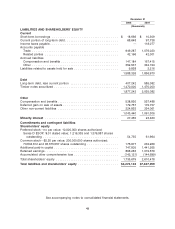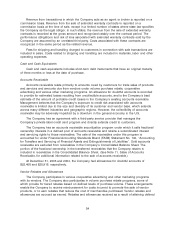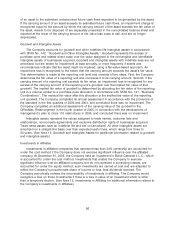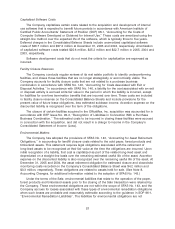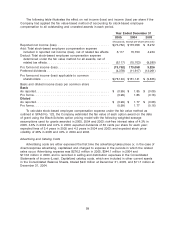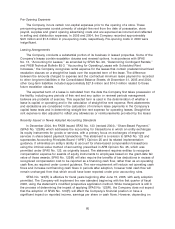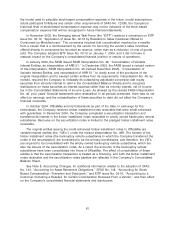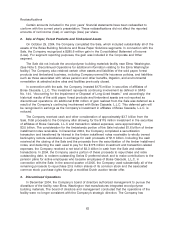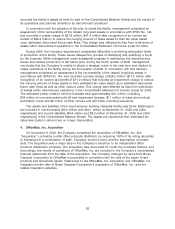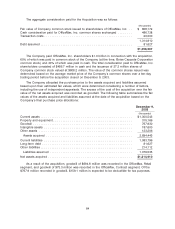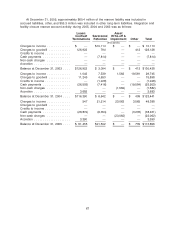OfficeMax 2005 Annual Report Download - page 61
Download and view the complete annual report
Please find page 61 of the 2005 OfficeMax annual report below. You can navigate through the pages in the report by either clicking on the pages listed below, or by using the keyword search tool below to find specific information within the annual report.Capitalized Software Costs
The Company capitalizes certain costs related to the acquisition and development of internal
use software that is expected to benefit future periods in accordance with American Institute of
Certified Public Accountants’ Statement of Position (SOP) 98-1, ‘‘Accounting for the Costs of
Computer Software Developed or Obtained for Internal Use.’’ These costs are amortized using the
straight-line method over the expected life of the software, which is typically three to five years.
Deferred charges in the Consolidated Balance Sheets include unamortized capitalized software
costs of $36.7 million and $57.3 million at December 31, 2005 and 2004, respectively. Amortization
of capitalized software costs totaled $25.6 million, $25.2 million and $22.7 million in 2005, 2004 and
2003, respectively.
Software development costs that do not meet the criteria for capitalization are expensed as
incurred.
Facility Closure Reserves
The Company conducts regular reviews of its real estate portfolio to identify underperforming
facilities, and closes those facilities that are no longer strategically or economically viable. The
Company accounts for facility closure costs that are not related to a purchase business
combination in accordance with SFAS No. 146, ‘‘Accounting for Costs Associated with Exit or
Disposal Activities.’’ In accordance with SFAS No. 146, a liability for the cost associated with an exit
or disposal activity is accrued at its fair value in the period in which the liability is incurred, except
for liabilities for one-time termination benefits that are incurred over time. These costs are included
in facility closure reserves on the Consolidated Balance Sheets and include provisions for the
present value of future lease obligations, less estimated sublease income. Accretion expense on the
discounted liability is recognized over the term of the obligations.
The closure of certain facilities acquired in the OfficeMax, Inc. acquisition was accounted for in
accordance with EITF Issue No. 95-3, ‘‘Recognition of Liabilities in Connection With a Purchase
Business Combination.’’ The estimated costs to be incurred in closing these facilities were accrued
in connection with the acquisition, and did not result in a charge to income in the Company’s
Consolidated Statement of Income (Loss).
Environmental Matters
The Company has adopted the provisions of SFAS No. 143, ‘‘Accounting for Asset Retirement
Obligations,’’ in accounting for landfill closure costs related to the sold paper, forest products and
timberland assets. This statement requires legal obligations associated with the retirement of
long-lived assets to be recognized at their fair value at the time the obligations are incurred. Upon
initial recognition of a liability, that cost is capitalized as part of the related long-lived asset and
depreciated on a straight-line basis over the remaining estimated useful life of the asset. Accretion
expense on the discounted liability is also recognized over the remaining useful life of the asset. At
December 31, 2005 and 2004, the asset retirement obligation for estimated closure and closed-site
monitoring costs recorded on the Company’s Consolidated Balance Sheet was $4.2 million and
$0.3 million, respectively. These obligations are related to assets held for sale. (See Note 8,
Accounting Changes, for additional information related to the adoption of SFAS No. 143.)
Under the terms of the Sale, environmental liabilities that relate to the operation of the paper,
forest products and timberland assets prior to the closing of the Sale transaction were retained by
the Company. These environmental obligations are not within the scope of SFAS No. 143, and the
Company accrues for losses associated with these types of environmental remediation obligations
when such losses are probable and reasonably estimable according to the guidance in SOP 96-1,
‘‘Environmental Remediation Liabilities’’. The liabilities for environmental obligations are not
57




